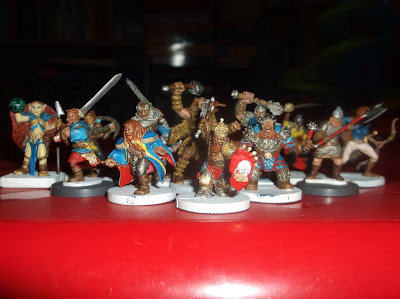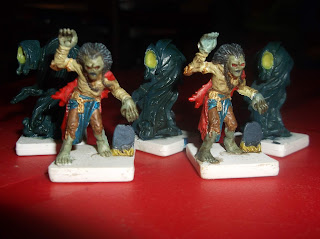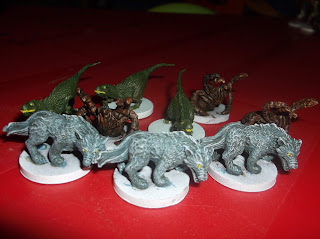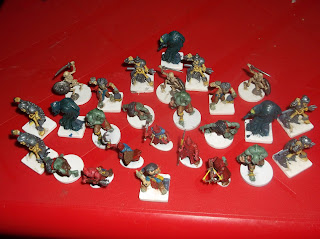For the first time in twenty years, I've started painting miniatures.
Initially, I felt as though I barely remembered which end of the brush to hold. I bought a sprue of Moria goblins off ebay, for no reason except that they were cheap, and used them for painting practise. The results, unsurprisingly, were pretty rough.
Still, I'd found painting them to be extremely relaxing, and it had given me a taste for painting goblins. So I pulled all the teeny-tiny goblin figures from my 1st edition Battlelore box and painted them, as well.
And then the goblin models from Arena of the Planeswalkers, for good measure.
By this point, my confidence, if not my skill, was increasing. So I decided to take on a bigger project: painting all the miniatures from the old D&D boardgame I bought earlier this year.
The next step, obviously, was to move onto the other board game I acquired at the same time, Legend of Drizzt, and its sister game, Castle Ravenloft. These came with a lot of miniatures, so getting them all painted up is clearly going to be a long-term project.
And some cultists and adventurers from Frostgrave:
So, four months in, here's what I have painted up so far.
The humanoid horde:
Dungeon dwellers:
 |
| WILL FIGHT FOR BEER. |
































I like your gargoyles. One technique I use when painting a large number of mooks is to base cost in black, then dry brush in white. After that I do a dark wash of the various colors on the white highlighted areas.
ReplyDeleteThanks! They were very quick and easy to do, too - just prime white, basecoat grey, wash black, drybrush white, done.
DeleteAnd I think I follow... so the black and white act as shading, and then all the colouring is done with (heavy) washes rather than actual paints? Even the details, like teeth and eyes? I'll have to give it a try...
I've had a bunch of Battlelore figures waiting to be painted for forever. I was an occasional playtester when that was being developed (maybe 6 or 8 times total), particularly when Richard wanted to test with 8 players (one on each side picking the card, then one for each zone deciding what to actually do).
ReplyDeleteHuh. I'd never have thought of playing Battlelore with eight players. Did it work?
Delete(I can imagine a version in which the players on each team are forbidden from communicating with one another except through gameplay, to simulate the fog of war: the only way you know what the commander of the right wing is planning is by watching what he's actually doing with his troops...)
That's pretty much what we were doing - the only spoken communication was along the lines of "left wing, two units" or to explain rules if an ability was triggered. It worked, but there was a lot of post-battle "I didn't expect you to do *that*" reaction. Which can be a good thing with a group. IIRC, we also didn't allow the zone commanders to see what cards the high commander held, so they didn't know how likely they were to get another turn soon. It's a very different game when you're playing the left wing and don't know if you've got three more cards that'll let you activate or none.
DeleteThat's a goodly horde - especially in just four months! I love the full group of dungeon gribblies in the penultimate photo. And the skeletons look very nice too.
ReplyDeleteWhat are you planning to do with the bases? You can get a great texture with coarse pumice gel - but even just painting dark brown or grey and drybrushing lightly with white before edging in black would finish them off nicely. Or, for a neat minimalist approach, you could just paint them solid black.
I'd echo Darnizhaan's point about black undercoat and drybrushing. Pebeo black gesso (about a fiver on Amazon) is great stuff for undercoating: you slop it on, it tightens over the miniature as it dries and it doesn't smell. One of my speed-painting techniques is to drybrush in grey, then white, and then 'tint' very thin colours over the top of that. The results are bit dull, but if you paint the faces more solidly and brightly, you get a nice contrast. I put a bit of a tutorial on it together here:
http://leadadventureforum.com/index.php?topic=77384.msg1268280#msg1268280
(It goes on for a page or so.)
Another good speed-painting technique is to undercoat in white and then wash with black or brown ink (Citadel's Agrax Earthshade or whatever), then drybrush with white. That give you a nice gradient, and you can then tint in very thin colours and 'seal' them with ink or a Citadel wash. The trick is to really thin the colours, so that the gradient created by the earlier process shines through. I set out the steps here - it's really easy because the sculptor is effectively painting the miniature for you:
http://leadadventureforum.com/index.php?topic=77384.msg1278760#msg1278760
One tip for eyes that you might (or might not!) find useful is to wash the socket with a dark blue or green ink (GW's Nightshade or Coelian whatever it is), and then just pick out the eye itself with white (or off-white), before either touching in a pupil or painting over the white with red or yellow. That gives you a nice dark eye-socket, which gives plenty of contrast with the bright eye. It's a tip that Aly Morrison set out in White Dwarf many, many moons ago ...
I'm planning to experiment with different kinds of basing, but haven't got around to it yet. Hopefully one where I can just paint the base with glue, dip it into the basing material, and then paint a black ring around the edge of the base. I expect it'll take a few experiments before I find one that works.
ReplyDeleteWhat's your technique with pumice gel? Paint it onto the base for texture, and then basecoat and drybrush?
Thanks for the links. So black gesso prime, heavy drybrush grey, slightly softer drybrush white, and then do all the colouring via inks or watered-down paints? Hmm. *Hmmm*. I'll order some gesso and give it a try. I'll also try the 'eyeshadow effect' for eyes...
With pumice gel (the Golden coarse stuff), I just spread it onto the base with a knife blade, cocktail stick or one of the kids' Fimo tools. It dries in a couple of hours - or much less on a radiator. I usually paint it and either drybrush it up or give it a wash and then drybrush it once the wash has dried. My general formula would be light colour, darker wash, drybrush with a lighter colour. So, for grass (as here: https://hobgoblinry.blogspot.com/2018/12/out-of-toybox.html), I use GW's Elysian Green, then wash with Biel-Tan Green, then drybrush with buff (GW's Ushtabi Bone?) and then very lightly with Vallejo's silver-grey or GW's Wych Elf Flesh (the same shade). For 'dungeon rubble' or 'churned earth' (like these guys: https://hobgoblinry.blogspot.com/2018/12/an-ogre-and-some-more-orcs.html), I use Vallejo burnt umber, mid-sea grey and white (no washes, just two drybrushes). For sci-fi (like these fellows: http://leadadventureforum.com/index.php?topic=88065.msg1321731#msg1321731), I use mid-sea grey, a wash of GW's Nightshade and a drybrush with white (it's the quickest and easiest by far).
ReplyDeleteObviously, lots of people do this a lot better than me - but quick paintjobs on pumice gel give a reasonable effect on the tabletop. And the bases don't moult, which is a real advantage over flock, I think. The main thing is that you get a texture to drybrush, so a medium or dark shade and then a light shade (or even just very light drybrushing in white) picks that out and gives a bit of contrast.
One thing to stress with the black/grey/white method of speed painting is that it works best when you use a little more care around the focal point (usually the face). These night goblins (http://leadadventureforum.com/index.php?topic=77384.msg1269650#msg1269650) encapsulate that. The robes and weapon hafts are just single thinned washes of colour over the 'preshading' created by the drybrushing over black, but the faces got a more solid coat of colour, a wash and higlights in Wych Elf Flesh.
Actually, that's something I find very useful: Wych Elf Flesh (or Vallejo silver-grey) is a great 'universal' highlight. It's got just the right level of opacity to be used to highlight almost any colour when thinned down. You can use it to pick out the brow and nose/snout of a greenish goblin, a blue slann, a red demon or a human of any skin tone. And it's just as good for 'edge highlights' on clothing, leather or weapon hafts. Or, if you want more speed, you can just drybrush it unthinned but using a VERY dry brush, so that only the slightest traces are left on raised areas. For good drybrushing brushes, the best I've found are Artmaster Pearl Series 22; they're very cheap and durable, and have just the right mix of softness and resistance in the bristles.
Apologies for such long comments! I've got a bit of an obsession with speed painting, given the need to churn out fresh monsters for each RPG session with the kids and their friends. They have an unforgiving "what you see is what you get" approach: "We've KILLED that goblin ALREADY!".
Thanks for the tips! Painting new monsters for each (weekly?) game session sounds like a Sisyphean task. I hope they'll give you time off over Christmas!
DeleteFor the man who wrote this: http://udan-adan.blogspot.com/2016/05/the-lost-colours-of-d.html I wonder why you stuck with all the new (or standard) color schemes. Let's see some purple ogres Joseph!
ReplyDeleteGREETINGS FROM THE GREAT GRAND MASTER! IN REGARDS OF YOU BECOMING A MEMBER OF THE GREAT ILLUMINATI, WE WELCOME YOU. Be part of something profitable and special (WELCOME TO THE WORLD OF THE ILLUMINATI). Are you a POLITICIAN,ENGINEER,DOCTOR, ENTERTAINER,MODEL,GRADUATE/PASTOR,OR YOU HAVE IT IN MIND TO EXPAND YOUR BUSINESS TO BECOME GREAT MINDS. It is pertinent to also know that For becoming a member, and earn the sum of $100,000,000.00 as the Illuminati membership salary monthly. “OPPORTUNITY” The great Illuminati Organization makes you rich and a part of these GOLDEN famous in the world, it will pull you out from the grass root and take you to a greater height were you have long aspired to be and together we shall rule the world with the great and mighty power of the Illuminati, long life and prosperity here on earth with eternal life and jubilation. contact us with the official, also email worldilluminaticentre@gmail.com,or whatsapp on +2349031652461 We await to lead you to your destiny....
ReplyDeleteI know that this is spam but I'm leaving it here because it's also hilarious. I hope the Illuminati Great Grand Master Ferdinand Robeto makes sure that his followers really *earn* their hundred million dollar monthly salaries.
Delete